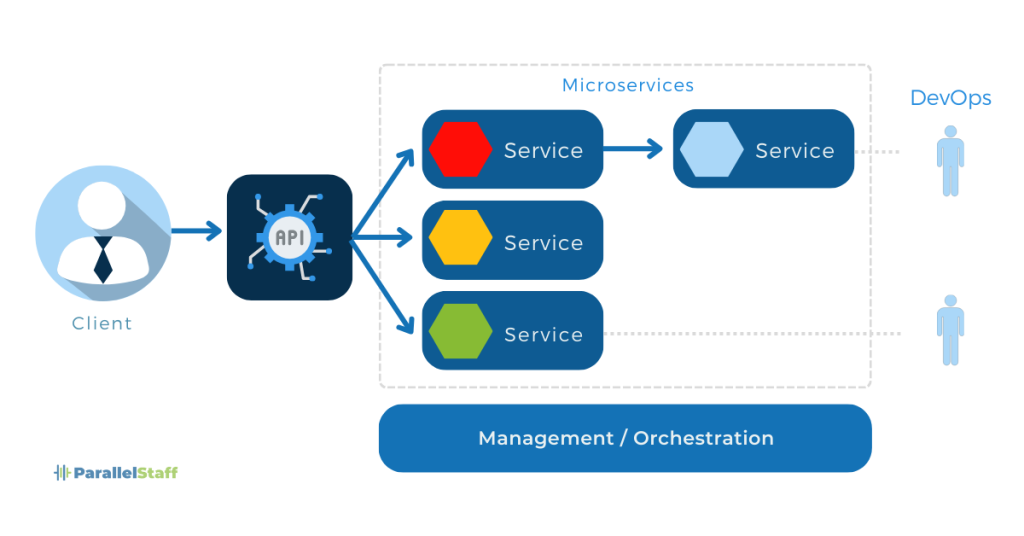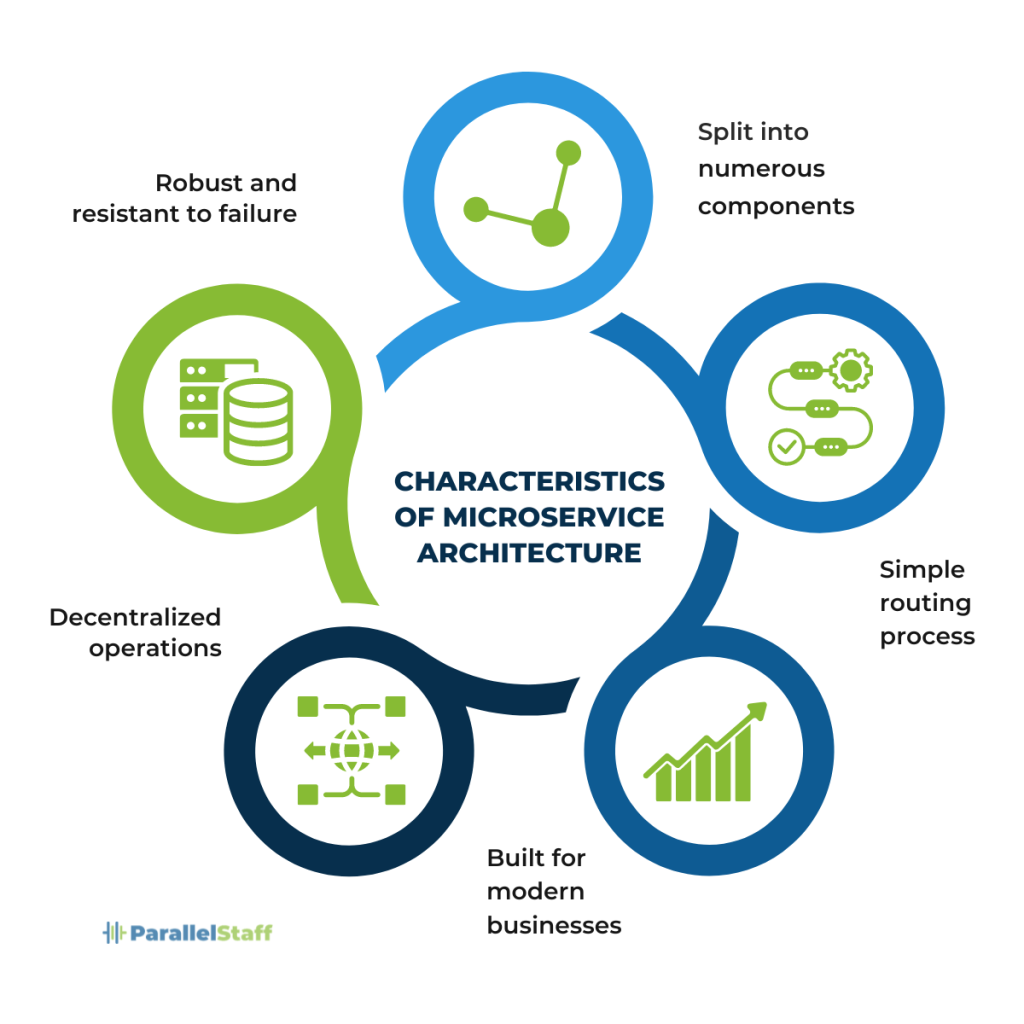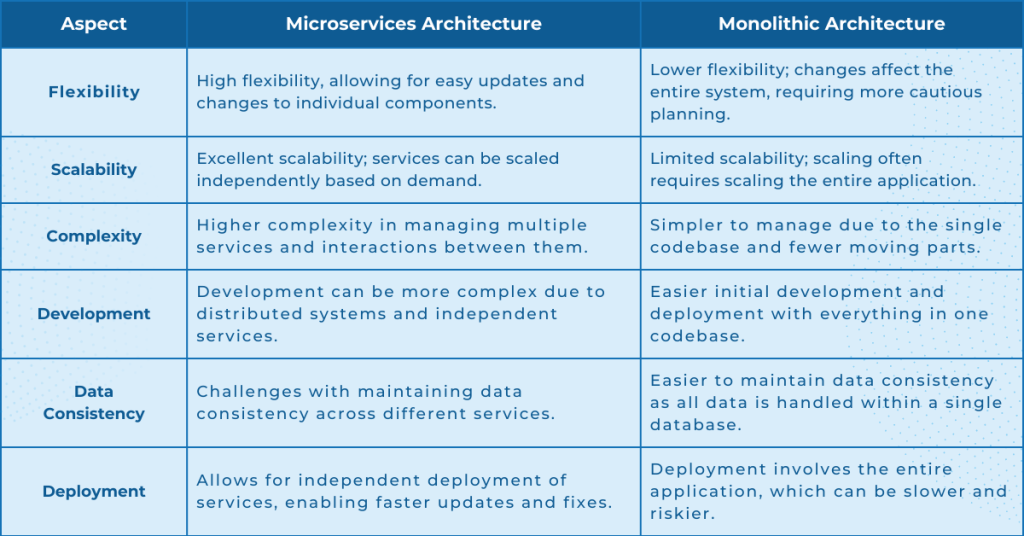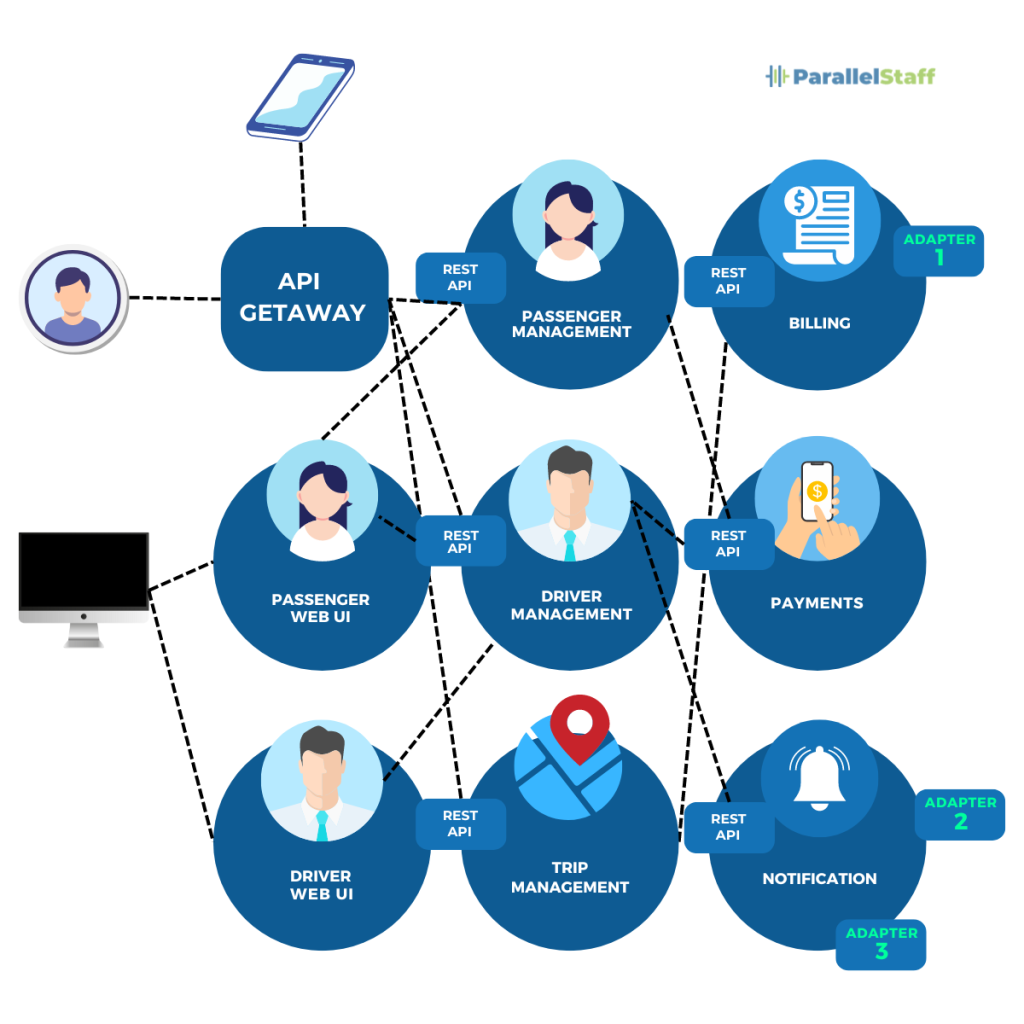Microservices architecture has emerged as a pivotal model in modern software engineering, offering a solution to traditional monolithic systems’ scalability and agility limitations. This architectural style structures an application as a collection of loosely coupled services, improving modularity and scaling the application part by part.
The microservices architecture market is on a robust growth trajectory, with a significant increase from $5.34 billion in 2023 to an expected $6.41 billion in 2024, achieving a 20.0% compound annual growth rate (CAGR). This surge is driven by the rapid rise of cloud computing, a cultural shift towards DevOps practices, and the ever-growing demands for scalability and data security, indicating a promising future for microservices architecture.
By 2028, the market is projected to reach $13.14 billion, maintaining a CAGR of 19.7%. Key drivers for this growth include the adoption of serverless architectures, integration with the Internet of Things (IoT), and enhanced security measures. Upcoming trends point towards AI-driven DevOps, event-driven architectures, and advanced hybrid cloud management, highlighting microservices architecture’s ongoing evolution and importance in modern digital infrastructures.
This article discusses a microservices architecture, how it works, and the model’s future.
Definition of Microservices Architecture
Microservices architecture designs software applications as a collection of small, independent services that operate in distinct processes and communicate using lightweight means, typically an HTTP-based API.

Unlike traditional monolithic software architectures with all components interconnected and deployed as a single unit, microservices principles use a modular approach. This enables each component or service to be created, deployed, maintained, and scaled separately.
Benefits of Adopting Microservices Architecture
Adopting microservices architecture offers numerous benefits:
- Scalability: Due to their distributed nature, microservices can be scaled independently, allowing for a more precise, cost-effective, and efficient allocation of resources.
- Agility: Independent service deployment speeds up the development cycles, enabling teams to bring innovations to market faster.
- Resilience: Isolated services reduce the risk of system-wide failures, enhancing the overall stability of applications.
- Technological Diversity: Teams can utilize different frameworks, languages, and data storage technologies best suited for their specific service requirements.
Companies like Amazon and Netflix have reaped substantial benefits from migrating to microservices, primarily due to these advantages have allowed them to enhance operational efficiencies and customer satisfaction. We will talk more about these examples later in the article.
Understanding Microservices Architecture
Before exploring microservices in depth, it’s essential to understand their basic components and the principles that drive their operation.
Key Components of Microservices Architecture
Microservices architecture is characterized by several defining components, each contributing to the system’s flexibility, scalability, and resilience.

Independently Deployable Services
The foundation of microservices architecture is that each microservice works as a separate unit, allowing it to be built, deployed, updated, and scaled independently of others. This autonomy enables faster updates and additions, resulting in shorter deployment cycles without jeopardizing the overall system.
Decentralized Data Management
Unlike monolithic designs, which frequently rely on a single database as a bottleneck and single point of failure, microservices take a decentralized approach to data management. Each microservice has its database, which aids in localizing data governance challenges and eliminating data dependencies, frequently hindering scaling and performance in centralized systems.
This configuration improves performance and considerably reduces the likelihood of widespread data discrepancies.
Isolated Failure
In a microservices architecture, services are designed to fail separately, reducing the risk that one service’s failure may disrupt the operation of others. This service isolation assures that if one service fails, the remainder of the system will continue to work correctly. For example, if the “Buy Now” button breaks on Amazon, it won’t impact the ability to display product recommendations as the services are independent,
The capacity to contain failures at the microservice level increases the system’s overall resilience and saves downtime, which is crucial for sustaining high availability and service continuity.
Working Principle of Microservices Architecture
The core principle of microservices architecture revolves around building an extensive application as a collection of more minor, modular services. Each of these services communicates with others through clearly defined APIs. Ownership of these services lies with small, autonomous teams, each responsible for their respective service from development to deployment. This structure greatly simplifies both the understanding and development of the application.
Furthermore, it fosters innovation by allowing teams to operate independently with limited need for cross-communication. This autonomy speeds up decision-making processes and enables quicker adaptations to market changes or new technology integrations, making the architecture highly efficient and adaptable.
If a specific team lacks the suitable skill set, you can benefit from outsourcing software development for those individual tasks.
Comparison of Microservices Architecture and Monolithic Architecture
The primary distinction between microservices and monolithic architecture is in how functionality is set up. Monolithic applications are designed as a single coherent unit, whereas microservices comprise small, interconnected services.
This fundamental distinction impacts everything from development to application scaling and maintenance.
The table below shows a more detailed comparison of the two approaches.

Transitioning to Microservices Architecture
Organizations typically consider transitioning to microservices when their monolithic architecture impedes agility, scalability, or reliability. Factors prompting this shift include faster deployment cycles, improved scalability, and the desire to adopt new technologies without overhauling the entire system.
Process of Transitioning
Transitioning to microservices architecture is a systematic process that involves several critical steps, each designed to ensure a smooth shift from a monolithic system to a more modular, scalable environment.
1. Identifying Services
The first step is to split down the present application into different services. This breakdown is usually based on business capabilities or logical separations inside the application. For example, user administration, order processing, and inventory control functions may become independent services.
2. Defining APIs
Once services have been determined, the next challenge is to create precise and efficient APIs that allow these services to interact. These APIs serve as contracts between services, detailing how data is shared and processed while guaranteeing that interactions stay consistent and trustworthy even when services are deployed independently.

3. Selecting Technology
After defining the services and APIs, select the right technology stack for each microservice. This includes choosing programming languages, frameworks, and infrastructure best suited to each service’s unique requirements. This decision is critical since it impacts each microservice’s performance, scalability, and maintenance.
4. Migrating Data
A significant problem in migrating to microservices is identifying data ownership for each service and shifting data from a centralized monolithic database to distributed databases tailored to each service’s needs. This step frequently includes creating separate databases for each microservice or implementing specific data management patterns, such as Command Query Responsibility Segregation (CQRS), to handle complicated data operations more efficiently.
Organizations can successfully shift to a microservices architecture by carefully managing these processes, reaping the benefits of scalability, flexibility, and greater innovation capabilities. Each phase must be appropriately planned and implemented to reduce issues during the transition and enhance the new system’s efficiency.
Microservices Architecture Patterns
Microservices architecture patterns provide strategic recommendations for shaping and managing services inside a microservices system. These patterns address common issues encountered while designing and deploying microservices.
They show you how to split down a monolithic program properly, provide smooth communication between services, and manage data across the architecture. Developing a thorough understanding of these patterns is critical for creating a robust and scalable microservices architecture.
Decomposition Patterns
Decomposition patterns are necessary for moving from a monolithic to a microservices design. They advise developers on how to break down an application into smaller, more manageable sections.
- Decomposition by Business Capability: This method involves identifying and separating services based on specific business functions, allowing each service to focus on a single business goal.
- Decomposition by Subdomain: This approach uses domain-driven design principles to split the application according to different domain areas, ensuring each microservice encapsulates a particular domain logic.
Both patterns provide a clear framework for identifying which parts of an application can be independently developed, deployed, and scaled as separate services.
Integration Patterns
Once services are decomposed, integration patterns play a crucial role in defining how these services communicate and work together to form a complete system. Key integration patterns include:
- API Gateways: This pattern involves using a service that acts as an entry point for all client requests, directing them to the appropriate microservices and handling results aggregation.
- Service Meshes: In this pattern, a dedicated infrastructure layer handles service-to-service communications, providing capabilities like service discovery, load balancing, and secure connections.
- Event-Driven Approaches: This pattern uses events to trigger and communicate between services, promoting loose coupling and enhancing scalability by asynchronously processing requests.
Choosing the right integration pattern is vital for ensuring services can interact efficiently without creating dependencies that could lead to failures or bottlenecks.
Database Patterns
Effective data management is a cornerstone of successful microservices architecture. Database patterns provide strategies for how data is stored, accessed, and managed across different services, including:
- Shared Database: Although less common in microservices due to coupling issues, this pattern involves multiple services accessing the same database, simplifying data management at the cost of higher coupling.
- Database per Service: Each service manages its database, thus ensuring full autonomy and reducing data contention but requiring careful handling of data consistency.
- Saga Pattern: This pattern is used for managing long-running transactions that span multiple services, ensuring data consistency without the need for distributed transactions.
Implementing appropriate database patterns is critical to managing data in a microservices environment, balancing autonomy, consistency, and performance.
Implementing Microservices Architecture
Best Practices for Implementation
Successfully implementing microservices architecture involves a strategic approach to system design and operation.
- Focus on Continuous Delivery: Prioritize automating deployments to facilitate the swift and reliable release of new features. This approach helps maintain a steady flow of updates without sacrificing quality, ensuring that your application remains dynamic and competitive.
- Adopt DevOps Practices: By integrating your development and operations teams, you can significantly boost collaboration and streamline the delivery cycles. This synergy is crucial in a microservices environment, where various services need to be deployed and managed seamlessly.
- Implement Service Monitoring: Establish comprehensive monitoring of service performance in real-time. This proactive measure allows for immediate detection and resolution of issues, minimizing downtime and improving service reliability.
Common Pitfalls and How to Avoid Them
While microservices offer numerous benefits, certain common pitfalls can undermine their effectiveness.
- Overcomplicating the System Design: Simplicity should be a core principle in microservices architecture. Avoid creating overly complex systems that are hard to maintain and scale. Instead, focus on building services around clear, manageable responsibilities.
- Poor Service Integration: Services need to communicate efficiently. Poor integration can lead to latency issues and bottlenecks. Ensure that your service interfaces are well-defined and that you employ appropriate integration patterns that match your architectural needs.
- Inadequate Monitoring: Without adequate monitoring, it’s difficult to understand the health of your services and react to issues promptly. Investing in robust monitoring tools and setting up detailed observability frameworks can help you maintain control over a distributed system.
Adhering to these best practices and being mindful of common pitfalls are key steps in successfully implementing a microservices architecture.
Microservices Architecture Tools and Technologies
Implementing a microservices architecture effectively requires the right tools and technologies to manage the complexities of distributed systems.
Containerization and Orchestration Platforms
Containerization packages an application and its dependencies into a consistent unit called a container, ensuring it runs uniformly across any environment. Orchestration automates container management, including deployment and scaling. These technologies streamline application development and management. In serverless vs. containers, serverless suits sporadic workloads with its auto-scaling, while containers better handle complex applications due to their control and consistency.
- Docker: Docker is a leading containerization technology that packages applications and their dependencies into a single container. This provides a consistent environment for microservices across different development, testing, and production settings. Containers are portable, lightweight, and easier to manage than traditional deployment methods.
- Kubernetes: Often paired with Docker, Kubernetes is an orchestration platform that automates the deployment, scaling, and operations of containerized services. It handles load balancing, disaster recovery, and service discovery, making it easier to manage microservices at scale.
- OpenShift: A Kubernetes-based platform that provides developer and operational tools to develop, deploy, and manage applications on cloud infrastructure. OpenShift enhances Kubernetes with additional features like CI/CD pipelines, service mesh, and advanced cluster management.
Microservices Frameworks
A microservice framework is a set of tools and libraries designed to help developers efficiently build, deploy, and manage microservices.
- Spring Boot: This popular Java-based framework accelerates the development of new microservices by simplifying the configuration and deployment process. Spring Boot has embedded servers like Tomcat or Jetty, allowing developers to launch applications without complex server setups.
- Micronaut: Known for its low memory footprint and fast startup times, Micronaut is designed to build modular, easily testable microservice applications. It supports various programming languages such as Java, Groovy, and Kotlin.
- js: For developers working with Node.js, Express.js offers a minimalistic and flexible approach to building microservices. It is known for its performance and robust routing capabilities, making it suitable for services that handle numerous HTTP requests.
Case Studies of Microservices Architecture
Companies like Netflix and Amazon have successfully implemented microservices to handle millions of users and dynamically adapt to changing demands.
Netflix
Netflix’s evolution from a monolithic to a microservices architecture is a prime example of successful adaptation in software development. Initially constrained by scalability and agility issues, Netflix adopted microservices to align with its expanding user base, enabling independent development across teams. This shift, driven by decentralization, fault isolation, and scalability, introduced challenges such as data consistency and system reliability, mitigated through robust monitoring systems and DevOps practices, including continuous integration and automated testing.
Implementing chaos engineering further enhanced system resilience by exposing vulnerabilities through intentional faults. These strategic moves significantly improved Netflix’s operational efficiency, allowing rapid adaptation to customer needs and market changes.
Switching to microservices enabled faster innovation, easier maintenance, and better content delivery management. It provided vital lessons in resilience and proactive system management for any organization looking to modernize its software architecture.
Uber
Uber’s journey from a monolithic application to a microservices architecture highlights its adaptive strategy as the company scales. Uber’s app was initially designed as a monolith to meet the straightforward demands of connecting drivers and riders in San Francisco. However, as Uber expanded into new cities and introduced additional services, the limitations of the monolithic structure became apparent.
Challenges included difficulty deploying updates—requiring a complete redeployment of the entire codebase—and the complexity of making changes due to the tightly coupled components, which required extensive insider knowledge.
Recognizing these issues, Uber transitioned to a microservices architecture, breaking the monolithic app into more minor, independent services. This shift allowed each component to operate independently, use its technology stack, and scale efficiently. The move facilitated continuous integration and delivery, accelerating Uber’s growth.

However, the transition to over 500 microservices introduced new challenges regarding system complexity, security, and resilience. Uber addressed these through innovations like Apache Thrift, which simplified service management and enhanced security by enforcing strict service contracts. Additionally, Uber developed latency and fault tolerance libraries to bolster system resilience, ensuring robust operations despite failures.
Adopting microservices enabled Uber to enhance development flexibility and operational stability, supporting its rapid expansion and complex operational needs.
The Future of Microservices Architecture: Emerging Trends
Integration of AI and Machine Learning
AI and machine learning are increasingly integrated into microservices to automate and enhance decision-making processes. These technologies enable predictive analytics and routine service task automation, boosting efficiency and innovation. As AI and ML evolve, their role in optimizing microservices workflows will become more pronounced, allowing for more intelligent, adaptive systems.
Increased Adoption of Serverless Architectures
Serverless computing is gaining traction in microservices, eliminating the need to manage servers and allowing automatic scaling and management. This model particularly benefits microservices environments, reducing operational complexities and costs while accelerating deployment. Serverless architectures are set to reshape how microservices are managed, focusing on coding over server management.
Use of Containers and Kubernetes
Kubernetes remains central to microservices, simplifying container orchestration and enhancing scalability. As more organizations adopt microservices, Kubernetes’ role in automating deployment, scaling, and management is critical. This trend is driving further advancements in container technologies, reinforcing Kubernetes as a cornerstone of microservices infrastructure.
Proliferation of Microservices Mesh
Service meshes like Istio and Linkerd are becoming essential in managing complex microservices communications. They provide automated handling of service discovery, load balancing, and security protocols. As microservices grow, the necessity for these meshes increases to maintain efficient and secure service interactions across increasingly complex systems.

Enhanced Focus on Security
Due to the architecture’s distributed nature, security in microservices is paramount. Trends include stronger access management, data encryption, and advanced security testing tools. These developments are crucial for protecting individual microservices and the entire architecture from emerging threats and ensuring system integrity.
Final Thoughts
As the landscape of software development continues to evolve, integrating cutting-edge practices like microservices architecture can significantly boost your organization’s efficiency and scalability. Understanding the trends and advancements in microservices—including AI integration, serverless architectures, and Kubernetes—can provide your projects with the agility and robustness needed to thrive in today’s competitive market.
If your organization is looking to adopt or enhance its microservices architecture and needs specialized, vetted talent to drive these initiatives, ParallelStaff is here to help. We offer nearshore staff augmentation that allows you to rapidly scale your in-house development team, ensuring that you have access to project-ready developers who are aligned with your time zone.
This not only offers a cost-effective solution by reducing overhead associated with full-time IT employees but also enables you to tap into specialized skills and expertise that might be scarce in your local talent pool.
Expand your team’s capabilities and seamlessly adjust workforce size to meet the dynamic demands of your projects. Contact ParallelStaff today to explore how our flexible, scalable solutions can contribute to the success and growth of your development initiatives.
- Staying Agile During a Hiring Freeze: The Role of IT Outsourcing - June 17, 2025
- Strategies to Improve the Software Development Life Cycle - June 13, 2025
- How Custom Software Can Streamline and Elevate Your Operations - May 8, 2025
